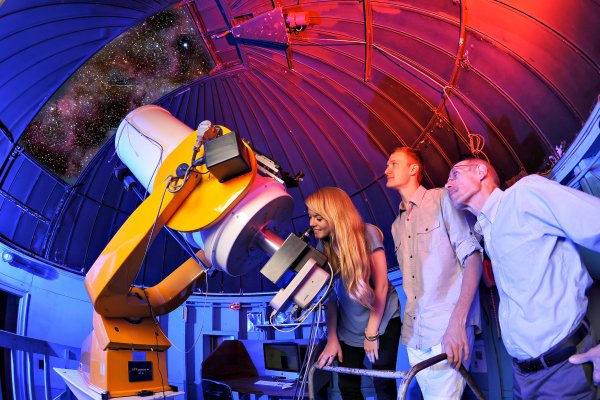Areas of Research
A broad range of research interests.
The physics and astronomy faculty are involved in cutting-edge research, often funded by external grants, that engage undergraduate student researchers.
Some of these research projects look to the heavens, others probe materials on the nanoscale, and some even look into the interior of nuclei.
 Using observatories around the Americas as well as space-based telescopes, research teams at Valpo are making new insights about astronomical objects. Research projects in this area look specifically at:
Using observatories around the Americas as well as space-based telescopes, research teams at Valpo are making new insights about astronomical objects. Research projects in this area look specifically at:
- planetary nebulae
- evolved stars
- supermassive-star/black-hole binary systems
- interacting binary stars
Faculty leading research in this area include Professors Todd Hillwig, Lukas Leisman, and Bruce Hrivnak.
In computational physics research, teams perform complex calculations to better understand aspects of the physical world. Valpo faculty leading research in this area include Professors Stan Zygmunt and Haiying He.
Generally, Professor He conducts computational studies of nanoscale materials and their applications in electronics, energy and biology. Professor Zygmunt researches in the area of computational catalysis, which involves the calculation of the reaction pathways and energies of molecules interacting with catalytic sites.
Recent research at Valpo has carried out computational modeling using first-principles methods. The research includes the computational study of nano heterostructures designed to catalyze reduction and oxidation reactions (collectively known as redox reactions). Researchers have investigated the redox reaction pathways and calculated the associated reaction energies and barriers — important indicators of the catalytic activity of the combined system. Their goal is to obtain clear insights into the bifunctional role the diode-like structure plays in facilitating the reduction and oxidation reactions.
This experimental research program seeks to learn more about the fundamental properties of nuclei and elementary particles, from which all matter in the universe is made. Faculty and students researching in this area carry out their experiments at particle accelerators and nuclear reactors such as:
- The Tri-Universities Meson Facility
- The Brookhaven National Laboratory Alternating Gradient Synchrotron
- The Brookhaven National Laboratory Relativistic Heavy Ion Collider
- The Fermi National Accelerator Laboratory
- The National Institute of Standards and Technology Center for Neutron Research
Recent and ongoing experiments have been funded by the U.S. Department of Energy and are completed in collaboration with physicists around the U.S. and abroad. The Valpo faculty leading research in this area include Professors Donald Koetke, Adam Gibson-Even, and Shirvel Stanislaus.
 Nanoscience research at Valpo is performed by Professor Andrew Richter and involves:
Nanoscience research at Valpo is performed by Professor Andrew Richter and involves:
- using x-rays to watch proteins adsorb onto nano-thin films and surfaces
- building thin, porous, polymer shells and films for sensor and drug delivery applications
- using neutron scattering to determine structure of nanoparticles.
For the x-ray work, Valpo researchers commonly travel to the Advanced Photon Source at Argonne National Lab outside of Chicago. This billion-dollar machine provides some of the most brilliant x-ray beams on the planet. For the neutron work, Valpo researchers have traveled to Oak Ridge National Laboratory in Tenn., the National Institute of Standards and Technology in Md. and the Institut Laue-Langevin in Grenoble, France.
